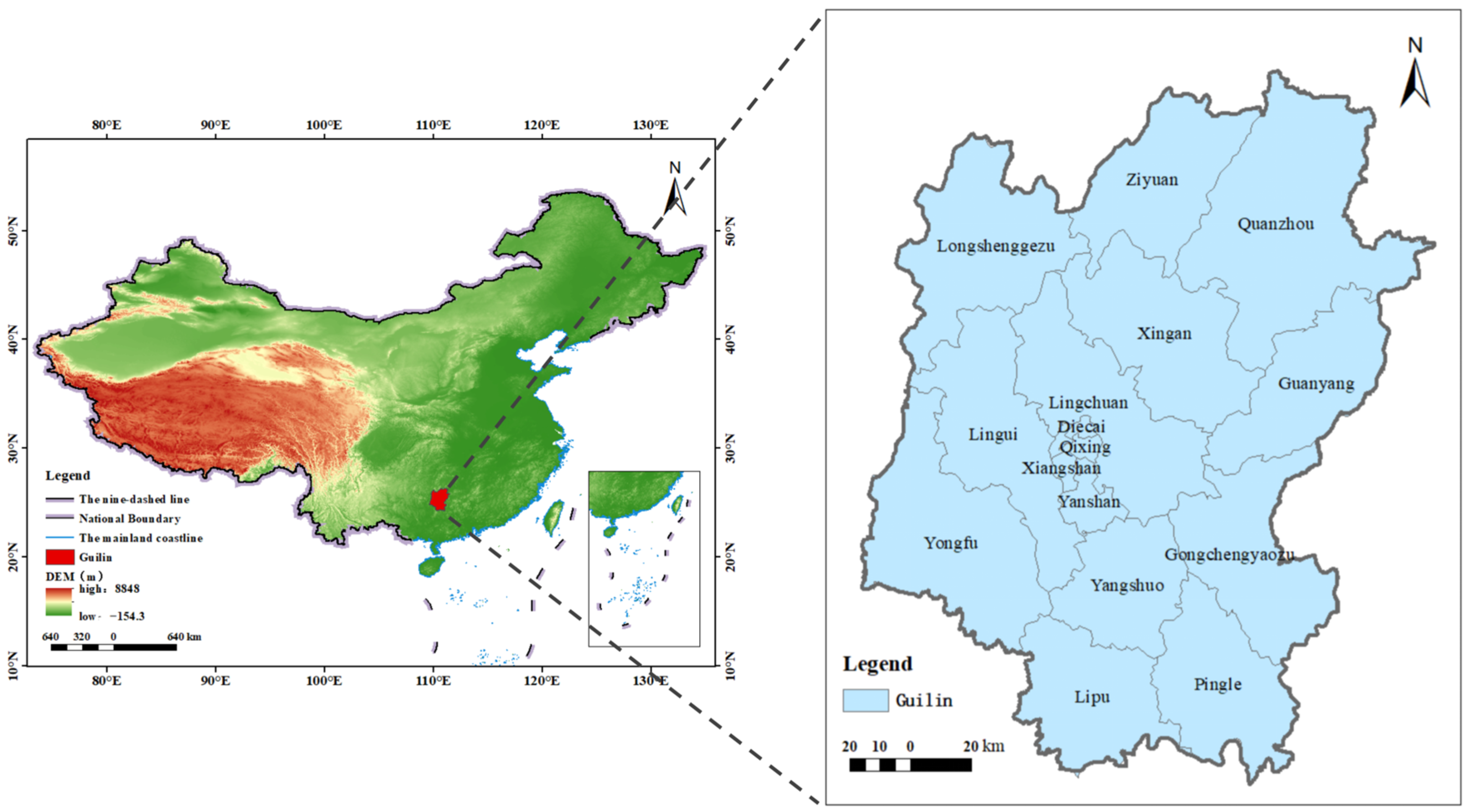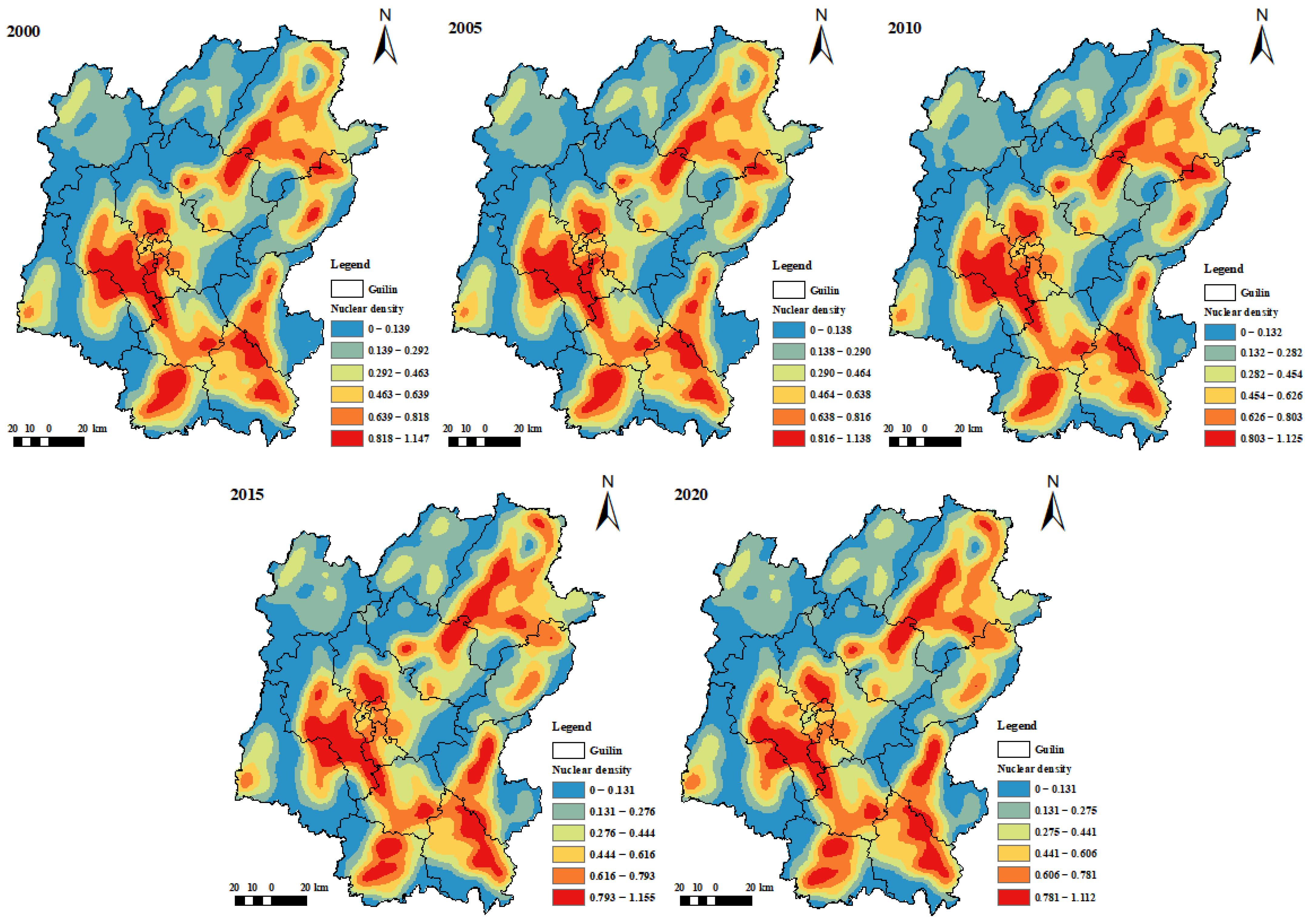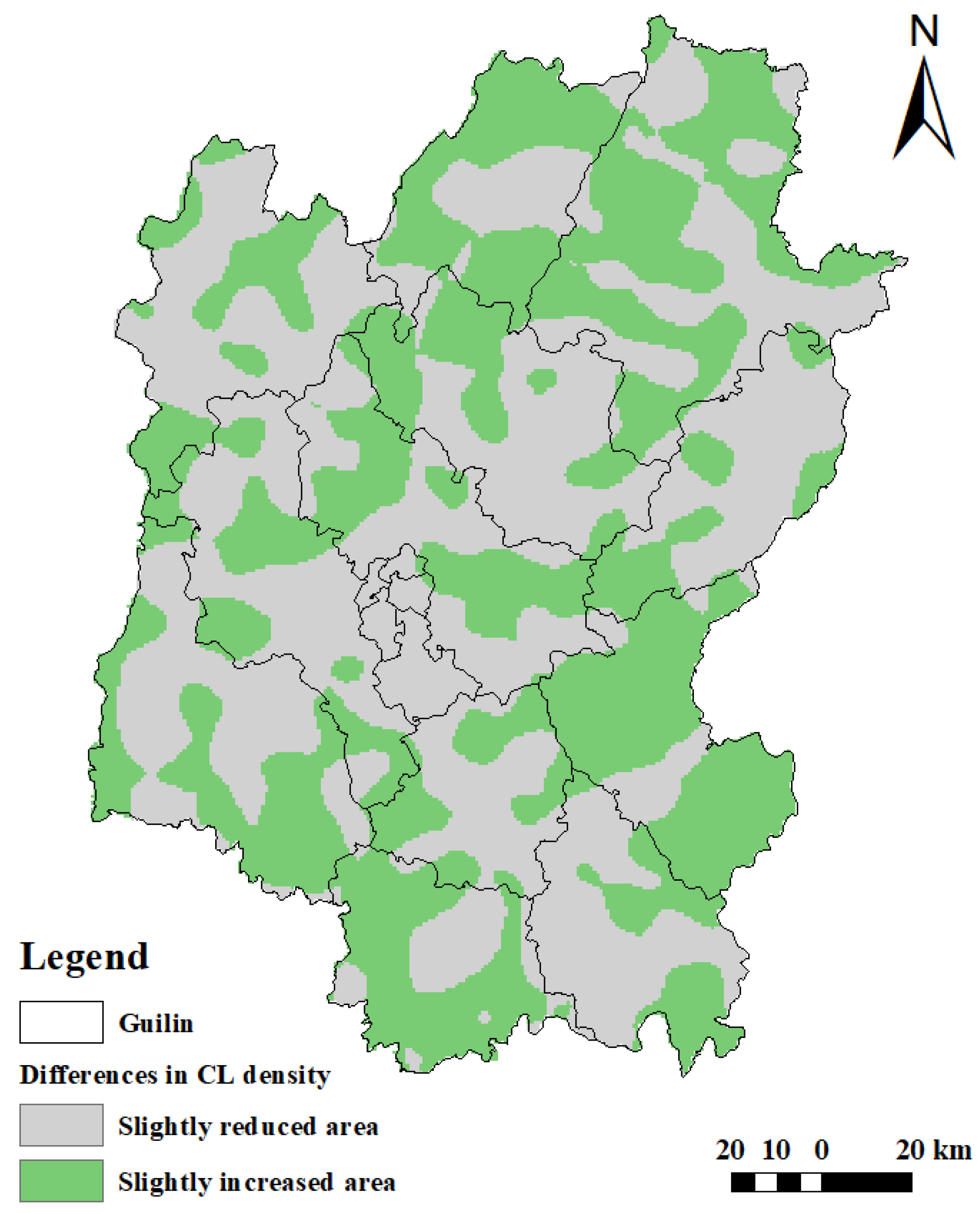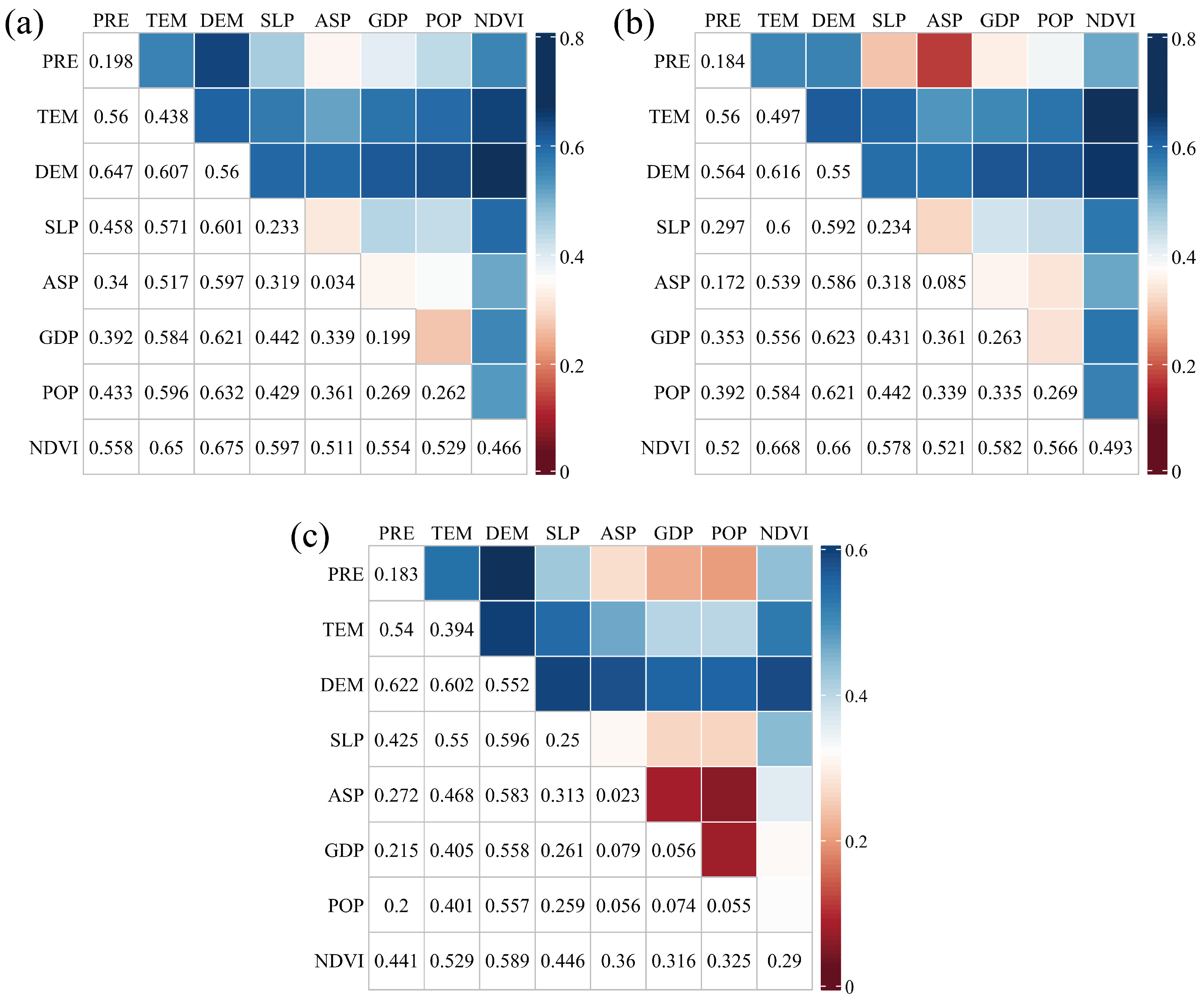Spatiotemporal Evolution and Driving Factors Analysis of Karst Cultivated Land Based on Geodetector in Guilin (Guangxi, China)
Abstract
1. Introduction
2. Materials and Methods
2.1. Study Area
2.2. Data Sources
- (1)
- Selection of Factors
- (2)
- Data Sources and Processing
2.3. Methodology
- (1)
- Kernel Density Estimation
- (2)
- Dynamic Degree of CL Change
- (3)
- Land Use Transfer Matrix
- (4)
- Geographical Detector
3. Results and Analysis
3.1. Spatiotemporal Distribution Characteristics of CL
3.2. Analysis of CL Change Dynamics
3.3. Characteristics of Driving Factor Changes
3.3.1. Variation in Single-Factor q Values
3.3.2. Variation in Interaction-Factor q Values
3.3.3. Sensitivity Analysis of Driving Factors
4. Discussion
5. Conclusions
- (1)
- CL continued to decrease in area with reduced spatial aggregation. Over the study period, the total CL area in Guilin decreased by 105.30 km2, with an annual change rate of −0.20%. Spatially, CL showed a general pattern of more in the southeast, less in the northwest, but the extent of high-density areas shrank significantly and fragmentation intensified. The loss was mainly due to conversion to construction land and forest land, particularly during 2010–2020.
- (2)
- Natural factors were the dominant drivers, while socio-economic influences increased. DEM and TEM were the most influential factors, with q-values consistently above 0.40, highlighting the rigid constraints of topography and climate on CL in KRs. At the same time, the impact of socio-economic factors grew continually: the q-value of GDP increased by 32.16% from 2010 to 2020, indicating a strengthening role of urbanization and industrialization in the loss of CL.
- (3)
- Factor interactions showed significant nonlinear enhancement. Although PRE and ASP had limited independent explanatory power, they were highly sensitive in interactions and markedly amplified the effects of other factors. The loss of CL reflected a dual pathway of non-agriculturalization and ecologicalization, signaling a functional shift from singular agricultural production to a multi-dimensional ecological–economic–social system. Under the dual pressures of economic development and ecological conservation, there is an urgent need to establish more refined and systematic mechanisms for CL protection and sustainable use.
Author Contributions
Funding
Data Availability Statement
Conflicts of Interest
Abbreviations
| ASP | Aspect |
| CDD | Comprehensive Dynamic Degree |
| CL | Cultivated Land |
| DEM | Elevation |
| GDP | Gross Domestic Product |
| KR | Karst Regions |
| POP | Population |
| PRE | Precipitation |
| SDD | Single Dynamic Degree |
| SLP | Slope |
| TEM | Temperature |
References
- Schmidhuber, J.; Tubiello, F.N. Global food security under climate change. Proc. Natl. Acad. Sci. USA 2007, 104, 19703–19708. [Google Scholar] [CrossRef]
- Rockström, J.; Williams, J.; Daily, G.; Noble, A.; Matthews, N.; Gordon, L.; Wetterstrand, H.; DeClerck, F.; Shah, M.; Steduto, P. Sustainable intensification of agriculture for human prosperity and global sustainability. Ambio 2017, 46, 4–17. [Google Scholar] [CrossRef] [PubMed]
- Zhou, Y.; Li, X.; Liu, Y. Cultivated land protection and rational use in China. Land Use Policy 2021, 106, 105454. [Google Scholar] [CrossRef]
- Liu, J.; Kuang, W.; Zhang, Z.; Xu, X.; Qin, Y.; Ning, J.; Zhou, W.; Zhang, S.; Li, R.; Yan, C. Spatiotemporal characteristics, patterns, and causes of land-use changes in China since the late 1980s. J. Geogr. Sci. 2014, 24, 195–210. [Google Scholar] [CrossRef]
- Zhou, B.-B.; Aggarwal, R.; Wu, J.; Lv, L. Urbanization-associated farmland loss: A macro-micro comparative study in China. Land Use Policy 2021, 101, 105228. [Google Scholar] [CrossRef]
- Guo, A.; Yue, W.; Yang, J.; Xue, B.; Xiao, W.; Li, M.; He, T.; Zhang, M.; Jin, X.; Zhou, Q. Cropland abandonment in China: Patterns, drivers, and implications for food security. J. Clean. Prod. 2023, 418, 138154. [Google Scholar] [CrossRef]
- He, T.; Jiang, S.; Xiao, W.; Zhang, M.; Tang, T.; Zhang, H. A non-grain production on cropland spatiotemporal change detection method based on Landsat time-series data. Land Degrad. Dev. 2024, 35, 3031–3047. [Google Scholar] [CrossRef]
- Zhang, Y.; Li, X.; Song, W.; Zhai, L. Land abandonment under rural restructuring in China explained from a cost-benefit perspective. J. Rural Stud. 2016, 47, 524–532. [Google Scholar] [CrossRef]
- Li, H.; Wu, Y.; Huang, X.; Sloan, M.; Skitmore, M. Spatial-temporal evolution and classification of marginalization of cultivated land in the process of urbanization. Habitat Int. 2017, 61, 1–8. [Google Scholar] [CrossRef]
- Shao, Y.; Jiang, Q.O.; Wang, C.; Wang, M.; Xiao, L.; Qi, Y. Analysis of critical land degradation and development processes and their driving mechanism in the Heihe River Basin. Sci. Total Environ. 2020, 716, 137082. [Google Scholar] [CrossRef] [PubMed]
- Fang, C.; Liu, H.; Wang, S. The coupling curve between urbanization and the eco-environment: China’s urban agglomeration as a case study. Ecol. Indic. 2021, 130, 108107. [Google Scholar] [CrossRef]
- Jiang, Z.; Lian, Y.; Qin, X. Rocky desertification in Southwest China: Impacts, causes, and restoration. Earth-Sci. Rev. 2014, 132, 1–12. [Google Scholar] [CrossRef]
- Wang, K.; Zhang, C.; Chen, H.; Yue, Y.; Zhang, W.; Zhang, M.; Qi, X.; Fu, Z. Karst landscapes of China: Patterns, ecosystem processes and services. Landsc. Ecol. 2019, 34, 2743–2763. [Google Scholar] [CrossRef]
- Zhang, W.; Qie, R. Spatiotemporal change of cultivated land in China during 2000–2020. PLoS ONE 2024, 19, e0293082. [Google Scholar] [CrossRef] [PubMed]
- Wang, J.; Wang, S.; Zhou, C. Quantifying embodied cultivated land-use change and its socioeconomic driving forces in China. Appl. Geogr. 2021, 137, 102601. [Google Scholar] [CrossRef]
- Wang, G.; Liu, Y.; Li, Y.; Chen, Y. Dynamic trends and driving forces of land use intensification of cultivated land in China. J. Geogr. Sci. 2015, 25, 45–57. [Google Scholar] [CrossRef]
- Foley, J.A.; Ramankutty, N.; Brauman, K.A.; Cassidy, E.S.; Gerber, J.S.; Johnston, M.; Mueller, N.D.; O’Connell, C.; Ray, D.K.; West, P.C. Solutions for a cultivated planet. Nature 2011, 478, 337–342. [Google Scholar] [CrossRef]
- Deng, X.; Huang, J.; Rozelle, S.; Zhang, J.; Li, Z. Impact of urbanization on cultivated land changes in China. Land Use Policy 2015, 45, 1–7. [Google Scholar] [CrossRef]
- Newbold, T.; Hudson, L.N.; Hill, S.L.; Contu, S.; Lysenko, I.; Senior, R.A.; Börger, L.; Bennett, D.J.; Choimes, A.; Collen, B. Global effects of land use on local terrestrial biodiversity. Nature 2015, 520, 45–50. [Google Scholar] [CrossRef]
- de Graaff, M.-A.; Hornslein, N.; Throop, H.L.; Kardol, P.; van Diepen, L.T. Effects of agricultural intensification on soil biodiversity and implications for ecosystem functioning: A meta-analysis. Adv. Agron. 2019, 155, 1–44. [Google Scholar]
- Ge, D.; Long, H.; Zhang, Y.; Ma, L.; Li, T. Farmland transition and its influences on grain production in China. Land Use Policy 2018, 70, 94–105. [Google Scholar] [CrossRef]
- Lichtenberg, E.; Ding, C. Assessing farmland protection policy in China. Land Use Policy 2008, 25, 59–68. [Google Scholar] [CrossRef]
- Li, M. The effect of land use regulations on farmland protection and non-agricultural land conversions in China. Aust. J. Agric. Resour. Econ. 2019, 63, 643–667. [Google Scholar] [CrossRef]
- Chen, Y.; Li, X.; Tian, Y.; Tan, M. Structural change of agricultural land use intensity and its regional disparity in China. J. Geogr. Sci. 2009, 19, 545–556. [Google Scholar] [CrossRef]
- Yu, X.; Wang, Q.; Tian, M.; Ji, A. Exploring the Impact of Cultivated Land Utilization Green Transformation on Agricultural Economic Growth: Evidence from Jiangsu Province in China. Sustainability 2024, 16, 7032. [Google Scholar] [CrossRef]
- Bajocco, S.; De Angelis, A.; Perini, L.; Ferrara, A.; Salvati, L. The impact of land use/land cover changes on land degradation dynamics: A Mediterranean case study. Environ. Manag. 2012, 49, 980–989. [Google Scholar] [CrossRef] [PubMed]
- Ruiz, I.; Sanz-Sánchez, M.J. Effects of historical land-use change in the Mediterranean environment. Sci. Total Environ. 2020, 732, 139315. [Google Scholar] [CrossRef]
- Lark, T.J.; Spawn, S.A.; Bougie, M.; Gibbs, H.K. Cropland expansion in the United States produces marginal yields at high costs to wildlife. Nat. Commun. 2020, 11, 4295. [Google Scholar] [CrossRef]
- Fudge, R.; Lovdal, A.; Zimmerman, E.; Kushner, L.; Grossman, J. Environmental outcomes of landscape-scale agricultural transitions in the Upper Midwestern US. Front. Sustain. Food Syst. 2025, 9, 1499410. [Google Scholar] [CrossRef]
- Schmitz, C.; Kreidenweis, U.; Lotze-Campen, H.; Popp, A.; Krause, M.; Dietrich, J.P.; Müller, C. Agricultural trade and tropical deforestation: Interactions and related policy options. Reg. Environ. Change 2015, 15, 1757–1772. [Google Scholar] [CrossRef]
- Othman, J. Linking agricultural trade, land demand, and environmental externalities: Case of oil palm in Southeast Asia. ASEAN Econ. Bull. 2003, 20, 244–255. [Google Scholar] [CrossRef][Green Version]
- Tovar, C.; Seijmonsbergen, A.C.; Duivenvoorden, J.F. Monitoring land use and land cover change in mountain regions: An example in the Jalca grasslands of the Peruvian Andes. Landsc. Urban Plan. 2013, 112, 40–49. [Google Scholar] [CrossRef]
- Brandt, J.S.; Townsend, P.A. Land use–land cover conversion, regeneration and degradation in the high elevation Bolivian Andes. Landsc. Ecol. 2006, 21, 607–623. [Google Scholar] [CrossRef]
- Potapov, P.; Turubanova, S.; Hansen, M.C.; Tyukavina, A.; Zalles, V.; Khan, A.; Song, X.-P.; Pickens, A.; Shen, Q.; Cortez, J. Global maps of cropland extent and change show accelerated cropland expansion in the twenty-first century. Nat. Food 2022, 3, 19–28. [Google Scholar] [CrossRef]
- Fritz, S.; See, L.; Perger, C.; McCallum, I.; Schill, C.; Schepaschenko, D.; Duerauer, M.; Karner, M.; Dresel, C.; Laso-Bayas, J.-C. A global dataset of crowdsourced land cover and land use reference data. Sci. Data 2017, 4, 1–8. [Google Scholar] [CrossRef]
- Keenleyside, C.; Tucker, G.; McConville, A. Farmland Abandonment in the EU: An Assessment of Trends and Prospects; Institute for European Environmental Policy: London, UK, 2010. [Google Scholar]
- Prishchepov, A.V.; Müller, D.; Dubinin, M.; Baumann, M.; Radeloff, V.C. Determinants of agricultural land abandonment in post-Soviet European Russia. Land Use Policy 2013, 30, 873–884. [Google Scholar] [CrossRef]
- Lark, T.J.; Hendricks, N.P.; Smith, A.; Pates, N.; Spawn-Lee, S.A.; Bougie, M.; Booth, E.G.; Kucharik, C.J.; Gibbs, H.K. Environmental outcomes of the US renewable fuel standard. Proc. Natl. Acad. Sci. USA 2022, 119, e2101084119. [Google Scholar] [CrossRef] [PubMed]
- Ramankutty, N.; Mehrabi, Z.; Waha, K.; Jarvis, L.; Kremen, C.; Herrero, M.; Rieseberg, L.H. Trends in global agricultural land use: Implications for environmental health and food security. Annu. Rev. Plant Biol. 2018, 69, 789–815. [Google Scholar] [CrossRef]
- Ren, W.; Yang, A.; Wang, Y. Spatial patterns, drivers, and sustainable utilization of terrace abandonment in mountainous areas of Southwest China. Land 2024, 13, 283. [Google Scholar] [CrossRef]
- Guo, H.; Sun, L.; Wu, S.; Siddique, K.H. The process and driving mechanism of abandoned terraces in mountain region at the watershed scale. Ecol. Eng. 2025, 215, 107582. [Google Scholar] [CrossRef]
- Liu, T.; Yu, L.; Liu, X.; Peng, D.; Chen, X.; Du, Z.; Tu, Y.; Wu, H.; Zhao, Q. A Global Review of Monitoring Cropland Abandonment Using Remote Sensing: Temporal–Spatial Patterns, Causes, Ecological Effects, and Future Prospects. J. Remote Sens. 2025, 5, 0584. [Google Scholar] [CrossRef]
- Chaudhary, S.; Wang, Y.; Khanal, N.R.; Xu, P.; Fu, B.; Dixit, A.M.; Yan, K.; Liu, Q.; Lu, Y. Social impact of farmland abandonment and its eco-environmental vulnerability in the high mountain region of Nepal: A case study of Dordi River Basin. Sustainability 2018, 10, 2331. [Google Scholar] [CrossRef]
- Verburg, P.H.; Crossman, N.; Ellis, E.C.; Heinimann, A.; Hostert, P.; Mertz, O.; Nagendra, H.; Sikor, T.; Erb, K.-H.; Golubiewski, N. Land system science and sustainable development of the earth system: A global land project perspective. Anthropocene 2015, 12, 29–41. [Google Scholar] [CrossRef]
- Long, H.; Zhang, Y.; Ma, L.; Tu, S. Land use transitions: Progress, challenges and prospects. Land 2021, 10, 903. [Google Scholar] [CrossRef]
- Jing, J.; Wei, F.; Jiang, H.; Chen, Z.; Lv, S.; Li, T.; Li, W.; Tang, Y. Prediction of Land Use Change and Carbon Storage in Lijiang River Basin Based on InVEST-PLUS Model and SSP-RCP Scenario. Land 2025, 14, 460. [Google Scholar] [CrossRef]
- Masoudi, M.; Richards, D.R.; Tan, P.Y. Assessment of the influence of spatial scale and type of land cover on urban landscape pattern analysis using landscape metrics. J. Geovis. Spat. Anal. 2024, 8, 8. [Google Scholar] [CrossRef]
- Zhou, K.; Sun, Z.; Ma, T.; Li, Y.; Xie, B. Spatiotemporal Heterogeneity and Zoning Strategies of Multifunctional Trade-Offs and Synergies in Cultivated Land in the Hexi Corridor. Land 2025, 14, 335. [Google Scholar] [CrossRef]
- Ye, Y.; Wang, Y.; Liao, J.; Chen, J.; Zou, Y.; Liu, Y.; Feng, C. Spatiotemporal pattern analysis of land use functions in contiguous coastal cities based on long-term time series remote sensing data: A case study of Bohai Sea Region, China. Remote Sens. 2022, 14, 3518. [Google Scholar] [CrossRef]
- Chen, G. Comparative Spatial Distribution Simulation of Plateau Mountain Cultivated Land Based on Spatial Multi-Scale Model, Yunnan Central Urban Agglomeration Area, China. Pol. J. Environ. Stud. 2023, 32, 3063–3080. [Google Scholar] [CrossRef]
- Xie, H.; He, Y.; Xie, X. Exploring the factors influencing ecological land change for China’s Beijing–Tianjin–Hebei Region using big data. J. Clean. Prod. 2017, 142, 677–687. [Google Scholar] [CrossRef]
- Prabhakar, S. A succinct review and analysis of drivers and impacts of agricultural land transformations in Asia. Land Use Policy 2021, 102, 105238. [Google Scholar] [CrossRef]
- Wang, J.; Xu, C. Geodetector: Principle and prospective. Acta Geogr. Sin. 2017, 72, 116–134. [Google Scholar]
- Zhou, Y.; Li, X.; Liu, Y. Land use change and driving factors in rural China during the period 1995–2015. Land Use Policy 2020, 99, 105048. [Google Scholar] [CrossRef]
- Shuanglong, C.; Wei, S.; Yuanzhe, L.; Han, L. Patterns and driving forces of cropland abandonment in mountainous areas. J. Resour. Ecol. 2022, 13, 394–406. [Google Scholar] [CrossRef]
- Li, X.; Yang, H.; Jia, J.; Shen, Y.; Liu, J. Index system of sustainable rural development based on the concept of ecological livability. Environ. Impact Assess. Rev. 2021, 86, 106478. [Google Scholar] [CrossRef]
- Wei, F.; Liang, Z.; Wang, Y.; Huang, Z.; Wang, H.; Sun, F.; Li, S. Exploring the Driving Factors of the Spatiotemporal Variation of Precipitation in the Jing-Jin-Ji Urban Agglomeration from 2000 to 2015. Sustainability 2020, 12, 7426. [Google Scholar] [CrossRef]
- Zhang, J.; Dai, M.; Wang, L.; Zeng, C.; Su, W. The challenge and future of rocky desertification control in karst areas in southwest China. Solid Earth 2016, 7, 83–91. [Google Scholar] [CrossRef]
- Wang, X.; Dong, X.; Liu, H.; Wei, H.; Fan, W.; Lu, N.; Xu, Z.; Ren, J.; Xing, K. Linking land use change, ecosystem services and human well-being: A case study of the Manas River Basin of Xinjiang, China. Ecosyst. Serv. 2017, 27, 113–123. [Google Scholar] [CrossRef]
- Tong, X.; Brandt, M.; Yue, Y.; Horion, S.; Wang, K.; Keersmaecker, W.D.; Tian, F.; Schurgers, G.; Xiao, X.; Luo, Y. Increased vegetation growth and carbon stock in China karst via ecological engineering. Nat. Sustain. 2018, 1, 44–50. [Google Scholar] [CrossRef]
- Silverman, B.W. Density Estimation for Statistics and Data Analysis; Routledge: London, UK, 2018. [Google Scholar]
- Dehnad, K. Density Estimation for Statistics and Data Analysis; Taylor & Francis: Abingdon, UK, 1987. [Google Scholar]
- Zhong, A.; Yang, G. Research on the Change of Land Use Agglomeration Based on Kernel Density Estimation and Hot Spot Analysis. In CRIOCM: International Symposium on Advancement of Construction Management and Real Estate, Proceedings of the International Symposium on Advancement of Construction Management and Real Estate, Wuhan, China, 28–30 November 2020; Springer: Singapore, 2021; pp. 987–1003. [Google Scholar]
- Song, W.; Pijanowski, B.C. The effects of China’s cultivated land balance program on potential land productivity at a national scale. Appl. Geogr. 2014, 46, 158–170. [Google Scholar] [CrossRef]
- Lambin, E.F.; Geist, H.J. Land-Use and Land-Cover Change: Local Processes and Global Impacts; Springer Science & Business Media: Berlin/Heidelberg, Germany, 2008. [Google Scholar]
- Jiang, L.; Yu, L. Analyzing land use intensity changes within and outside protected areas using ESA CCI-LC datasets. Glob. Ecol. Conserv. 2019, 20, e00789. [Google Scholar] [CrossRef]
- Pontius, R.G., Jr.; Shusas, E.; McEachern, M. Detecting important categorical land changes while accounting for persistence. Agric. Ecosyst. Environ. 2004, 101, 251–268. [Google Scholar] [CrossRef]
- Liu, J.; Zhang, Z.; Xu, X.; Kuang, W.; Zhou, W.; Zhang, S.; Li, R.; Yan, C.; Yu, D.; Wu, S. Spatial patterns and driving forces of land use change in China during the early 21st century. J. Geogr. Sci. 2010, 20, 483–494. [Google Scholar] [CrossRef]
- Huang, T.; Xu, J. The characteristics, causes and countermeasures of spatial-temporal evolution of guangxi cultivated land deagriculturalization in the past 40 years. Chin. J. Agric. Resour. Reg. Plan. 2023, 44, 40–51. [Google Scholar]






| Criterion | Interaction Type |
|---|---|
| q(X1∩X2) < Min(q(X1), q(X2)) | Nonlinear attenuation |
| Min(q(X1), q(X2)) < q(X1∩X2) < Max(q(X1), q(X2)) | Single factor nonlinear attenuation |
| q(X1∩X2) > Max(q(X1), q(X2)) | Dual factor enhancement |
| q(X1∩X2) = q(X1) + q(X2) | Independent |
| q(X1∩X2) > q(X1) + q(X2) | Nonlinear enhancement |
| Land Use Type | 2000–2010 | 2010–2020 | 2000–2020 | |||
|---|---|---|---|---|---|---|
| SDD | CDD | SDD | CDD | SDD | CDD | |
| Grassland | −0.08% | 0.01% | −0.06% | 0.03% | 0.13% | 0.04% |
| Construction land | 0.54% | 3.31% | 4.03% | |||
| Cultivated land | −0.03% | −0.16% | −0.20% | |||
| Forest land | 0.01% | −0.04% | −0.03% | |||
| Water bodies | 0.47% | 0.80% | 1.30% | |||
| Unused land | 5.04% | 2.41% | 8.67% | |||
| Variable | 2000 | 2010 | 2020 | |||
|---|---|---|---|---|---|---|
| q | p | q | p | q | p | |
| PRE | 0.198 | 0.000 | 0.184 | 0.05 | 0.183 | 0.000 |
| TEM | 0.438 | 0.000 | 0.497 | 0.000 | 0.394 | 0.000 |
| DEM | 0.560 | 0.000 | 0.550 | 0.000 | 0.552 | 0.000 |
| SLP | 0.233 | 0.000 | 0.234 | 0.000 | 0.250 | 0.000 |
| ASP | 0.084 | 0.03 | 0.085 | 0.04 | 0.084 | 0.03 |
| GDP | 0.199 | 0.000 | 0.263 | 0.000 | 0.315 | 0.03 |
| POP | 0.262 | 0.000 | 0.269 | 0.000 | 0.272 | 0.03 |
| NDVI | 0.466 | 0.000 | 0.493 | 0.000 | 0.290 | 0.000 |
Disclaimer/Publisher’s Note: The statements, opinions and data contained in all publications are solely those of the individual author(s) and contributor(s) and not of MDPI and/or the editor(s). MDPI and/or the editor(s) disclaim responsibility for any injury to people or property resulting from any ideas, methods, instructions or products referred to in the content. |
© 2025 by the authors. Licensee MDPI, Basel, Switzerland. This article is an open access article distributed under the terms and conditions of the Creative Commons Attribution (CC BY) license (https://creativecommons.org/licenses/by/4.0/).
Share and Cite
Zeng, S.; Wei, F.; Jiang, H.; Li, T.; Ren, Y. Spatiotemporal Evolution and Driving Factors Analysis of Karst Cultivated Land Based on Geodetector in Guilin (Guangxi, China). Appl. Sci. 2025, 15, 10635. https://doi.org/10.3390/app151910635
Zeng S, Wei F, Jiang H, Li T, Ren Y. Spatiotemporal Evolution and Driving Factors Analysis of Karst Cultivated Land Based on Geodetector in Guilin (Guangxi, China). Applied Sciences. 2025; 15(19):10635. https://doi.org/10.3390/app151910635
Chicago/Turabian StyleZeng, Shaobin, Feili Wei, Hong Jiang, Tengfang Li, and Yongqiang Ren. 2025. "Spatiotemporal Evolution and Driving Factors Analysis of Karst Cultivated Land Based on Geodetector in Guilin (Guangxi, China)" Applied Sciences 15, no. 19: 10635. https://doi.org/10.3390/app151910635
APA StyleZeng, S., Wei, F., Jiang, H., Li, T., & Ren, Y. (2025). Spatiotemporal Evolution and Driving Factors Analysis of Karst Cultivated Land Based on Geodetector in Guilin (Guangxi, China). Applied Sciences, 15(19), 10635. https://doi.org/10.3390/app151910635






